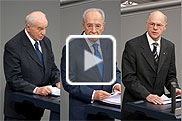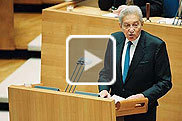Navigationpath: Homepage > Art and History > History > Day of Remembrance
Day of Remembrance for the Victims of National Socialism
On Wednesday, 27 January 2010, the German Bundestag came together in remembrance of the victims of National Socialism. The Ceremony of Remembrance in the plenary chamber of the Reichstag Building in Berlin began at noon. Following an introductory speech by Professor Norbert Lammert, President of the Bundestag, speeches were held by the President of the State of Israel, Shimon Peres, and Polish historian Professor Feliks Tych.
Sixty-five years ago, on 27 January 1945, soldiers of the Soviet Red Army liberated the German concentration camp Auschwitz, to the west of Kraków in southern Poland. Since 1940, people had been tortured, tormented and murdered there: Jews, above all, as well as Poles, Sinti and Roma, Soviet prisoners of war and prisoners of other nationalities.
National Day of Remembrance
In 1996, the German President of the day, Professor Roman Herzog, declared the 27th of January a national Day of Remembrance. Since then, a ceremony of remembrance has been held each year at the Bundestag, with those who witnessed the Holocaust first-hand invited to give speeches.
Shimon Peres, President of Israel, was born in what was then eastern Poland (now Belarus) in 1923, and emigrated to Tel Aviv with his family in 1934. In 1959 he became a Member of the Knesset, the Israeli Parliament. From 1977 to 1992 and from 2003 to 2005 he was chairman of the Israeli Labour Party. He has served as Prime Minister of Israel three times, and has been President of the country since 2007. In 1994 he was awarded the Nobel Peace Prize together with Yasser Arafat and Yitzhak Rabin.
Feliks Tych was born in Warsaw in 1929 and grew up in Radomsko (near Łódź), where his father owned a metal-working plant. His parents and siblings were murdered at Treblinka extermination camp, while false papers allowed him to survive. In 1970 he became an associate professor and in 1982 a full professor of history. After 1990 he took up visiting professorships at German universities on several occasions. From 1995 to 2007 he was the head of the Jewish Historical Museum in Warsaw.
Youth Encounter
To mark the Day of Remembrance, the German Bundestag traditionally organises a youth encounter; this year’s theme was "War, Occupation, Genocide - Poland after the German invasion, 1939-1945". Around 80 young people participated, mostly from Germany, but also from Poland (10), France (10) and other neighbouring countries. The youth encounter is targeted at young people who are actively involved in projects and initiatives which relate to the history of National Socialism or which work to counter xenophobia, anti-Semitism and racism.
The youth encounter programme began on 22 January, with the participants spending 23 to 26 January in Poland. Their time in Warsaw included visits to the Warsaw Rising Museum and the Institute of National Remembrance, the German Historical Institute, the German Embassy, the Jewish Historical Institute and the site of the former Warsaw Ghetto. The programme also included a visit to the memorial site at the former Treblinka extermination camp, to the north-east of Warsaw.
Photo exhibition "Eine Familie - One Family"
Following the Ceremony of Remembrance in the plenary chamber of the Bundestag, the young people also took part in a tour, together with Shimon Peres, Feliks Tych and Bundestag President Lammert, of the exhibition "Eine Familie - One Family" by Israeli photographer Vardi Kahana in the Reichstag Building. The exhibition is open to the public in the Paul Löbe Building in Berlin until 12 February.
The Ceremony of Remembrance was attended by Members of the German Bundestag, Federal President Professor Horst Köhler, Federal Chancellor Dr Angela Merkel, Bundesrat President Jens Böhrnsen, and the President of the Federal Constitutional Court, Professor Hans-Jürgen Papier.
Further Information
Further Information
English translation
-
Norbert Lammert (mp3 | 8.5 MB)
-
Shimon Peres (mp3 | 16.2 MB)
-
Feliks Tych (mp3 | 11.0 MB)



